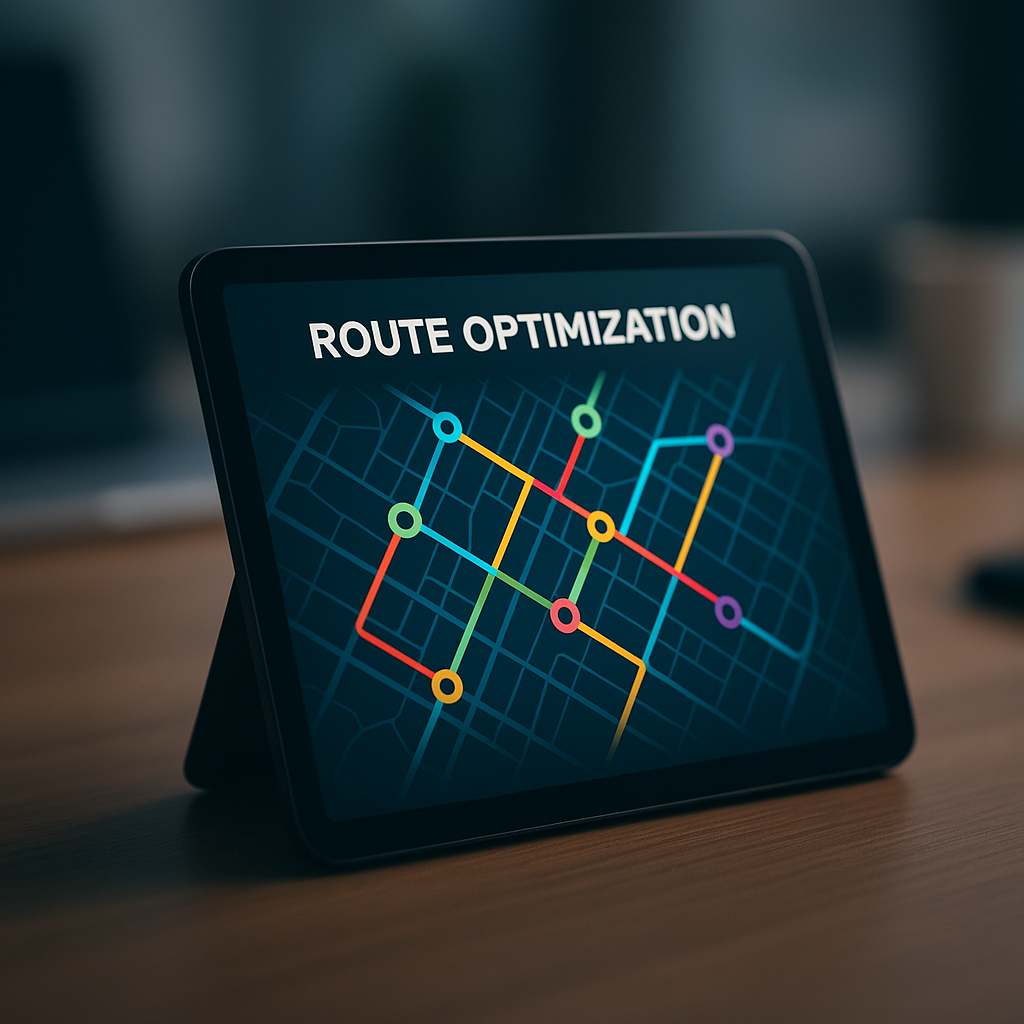Efficient route planning is more than a logistical necessity; it is a cornerstone of cost reduction and operational efficiency for modern businesses.
This blog post explains how route optimisation can drive significant savings, improve customer satisfaction, and streamline operations across various industries.
From understanding the core benefits of route optimisation to implementing advanced software solutions, discover how optimising delivery routes can transform your business outcomes.
Let's Get Straight to the Point
Efficient route optimisation helps businesses reduce operational costs, enhance customer satisfaction, and improve sustainability.
Companies can lower fuel and labour expenses, ensure timely deliveries, and boost resource utilisation by using advanced software to plan the most efficient routes.
Implementing and measuring the success of route optimisation strategies leads to substantial savings and long-term growth.

What is Route Optimisation?
1. Definition and Concept of Route Optimisation
Route optimisation is identifying the most efficient routes for vehicles to travel, aiming to reduce operational costs and improve customer satisfaction.
This involves analysing various factors such as traffic patterns, road conditions, vehicle capacity, and delivery schedules to determine the optimal route for deliveries or services.
Route optimisation is essential for logistics, field services, or delivery businesses. It reduces fuel consumption, lowers labour costs, and ensures timely deliveries, improving customer satisfaction.
2. Importance of Route Optimisation in Logistics and Delivery Businesses
Route optimisation is critical in logistics and delivery businesses. Companies reliant on transportation need it to minimise transportation costs, improve delivery times, and enhance service quality.
By planning efficient routes, businesses can improve resource utilisation, reduce environmental impact, and optimise vehicle capacity. Ultimately, this leads to significant cost savings and increased operational efficiency.
3. Brief Overview of the Benefits of Route Optimisation
The benefits of route plans and route optimisation are numerous. These include:
Reduced fuel consumption and lower fuel costs.
Enhanced customer satisfaction through timely deliveries.
Better labour productivity and reduced labour costs.
Improved operational efficiency and resource utilisation.
By implementing effective route optimisation strategies, businesses can achieve substantial cost savings and support business growth.

The Impact of Inefficient Routes
1. Effects of Inefficient Routes on Operational Costs
Inefficient routes can significantly increase operational costs. These include:
Higher fuel consumption due to longer distances.
Increased labour costs from longer driving times.
Elevated maintenance costs due to wear and tear on vehicles.
Poor route planning can also affect delivery, leading to delays and unnecessary expenses.
2. Consequences of Poor Route Planning on Customer Satisfaction
Poor route planning often delays or misses service calls, impacting delivery windows and reducing customer satisfaction. Late deliveries lead to:
Increased customer complaints.
Diminished customer loyalty.
Loss of repeat business opportunities.
Adopting route planning software and ensuring accurate estimated arrival times can help companies improve service quality and drive customer satisfaction.
3. Environmental Impact of Inefficient Routes
Inefficient routes contribute to the following:
Higher fuel consumption and emissions.
Increased traffic congestion and noise pollution.
Elevated environmental costs for businesses.
Optimising routes reduces these negative impacts, supports a more sustainable supply chain, and enhances overall resource utilisation.

Benefits of Route Optimisation
1. Reduced Fuel Consumption and Lower Fuel Costs
Efficient route optimisation reduces fuel consumption and minimises fuel costs. By calculating the most efficient route and avoiding traffic congestion, businesses can:
Decrease total distances travelled.
Reduce expenses tied to rising fuel prices.
Achieve significant savings in operating costs.
2. Improved Labour Productivity and Reduced Labour Costs
With efficient route planning, businesses can improve labour productivity by ensuring drivers spend less time on the road. This leads to:
Reduced overtime expenses.
More deliveries per driver within standard hours.
Better resource utilisation and increased efficiency.
3. Enhanced Customer Satisfaction and Loyalty
Businesses can improve their reputation and customer satisfaction by ensuring timely deliveries and adhering to planned delivery schedules. This fosters:
Higher customer retention.
Positive reviews and word-of-mouth.
Increased potential for business growth.

Route Optimisation Strategies
1. Technology and Software Solutions for Route Optimisation
Technology and software solutions are indispensable for effective route optimisation. Advanced algorithms and data analysis tools enable companies to identify the most efficient routes for their vehicles, significantly reducing operational costs and enhancing customer satisfaction.
By utilising route optimisation software, businesses can dynamically adjust their routes in real time, considering various factors such as traffic patterns, road conditions, and weather. This helps find the most efficient routes, reduces fuel consumption, and lowers emissions.
The ability to optimise routes on the fly ensures that deliveries are timely and resources are used efficiently, ultimately leading to improved customer satisfaction and substantial cost savings.
2. Improving Fleet Management through Route Optimisation
Effective fleet management is a cornerstone of successful route optimisation. By leveraging route optimisation software, companies can better manage their drivers and vehicles, reducing fuel consumption, minimising downtime, and extending fleet lifespan.
This software allows businesses to allocate resources more effectively, often reducing the number of vehicles needed and saving on fuel costs. Additionally, optimised routes contribute to more efficient and reliable transportation services, enhancing customer satisfaction.
By focusing on fleet management through route optimisation, companies can achieve significant cost savings and improve their overall operational efficiency.
3. Efficient Load Planning and Integration with Logistics Experts
Efficient load planning is another critical aspect of route optimisation. By planning loads more effectively, companies can reduce the number of trips required and make better use of vehicle capacity.
This not only saves on fuel costs but also maximises the efficiency of each trip. Integration with logistics experts can further enhance route optimisation efforts by providing valuable insights into the best routes and assisting with decision-making and planning.
By collaborating with logistics experts, companies can ensure that their routes are optimised for maximum efficiency and cost-effectiveness, leading to improved operational performance and substantial cost savings.
Choosing the Right Route Optimisation Software
1. Key Features to Consider When Selecting Route Optimisation Software
Choosing the right route optimisation software is critical for success. Businesses should look for:
Real-time traffic data for dynamic routing.
Integration with existing fleet management systems.
Support for customisable delivery schedules and vehicle capacity.
Software that includes these features ensures accurate planning routes and improves operational efficiency.
2. Importance of Scalability and Integration with Existing Systems
Scalability is vital for businesses experiencing growth. The ability to adapt software to meet changing demands ensures long-term usability.
Additionally, seamless integration with existing systems supports:
Smooth data transfer.
Enhanced planning time.
Consistent delivery process.
3. Tips for Evaluating Route Optimisation Software Vendors
When evaluating software vendors, consider the following:
The vendor’s track record and reputation.
Availability of customer support and training.
Flexibility in adapting to business-specific needs.
Businesses can choose software that delivers substantial cost savings by focusing on these criteria.
Implementing Route Optimisation Solutions
1. Strategies for Successful Implementation of Route Optimisation Software
Effective implementation requires careful planning. Strategies include:
Engaging the planning team to identify needs.
Conducting thorough training for users.
Piloting the system before full deployment.
These steps ensure smooth integration and significant savings.
2. Best Practices for Training and Onboarding Staff
Proper training ensures staff can fully utilise route optimisation software. Best practices include:
Offering hands-on training sessions.
Providing ongoing technical support.
Highlighting the key advantages of the system.
3. Overcoming Common Challenges and Obstacles
Challenges such as resistance to change or technical issues may arise. To address these:
Communicate the benefits of route optimisation.
Ensure robust support for troubleshooting.
Use data-driven decision-making to demonstrate impact.
Maximising Service Calls with Efficient Route Planning
1. Improving Time Management for Service Technicians
Optimising routes is important for improving service technicians' time management, enabling them to make the most of their workday.
By planning the shortest and most efficient routes, service technicians can reduce travel time and increase the number of service calls they can complete daily.
Route optimisation software plays a vital role in this process by automating scheduling, eliminating the need for manual planning and reducing human error risk.
With optimised routes and automated scheduling, service technicians can better meet customer preferences and expectations, increasing customer satisfaction and loyalty.
This not only enhances the efficiency of service operations but also contributes to the overall success and growth of the business.
Efficient Route Planning and Execution
1. Techniques for Creating Efficient Routes and Schedules
Creating efficient routes involves using advanced route planning software. Key techniques include:
Analysing historical data for optimal scheduling.
Factoring in real-time traffic conditions.
Adjusting routes dynamically as needed.
2. Importance of Real-Time Traffic Updates and Dynamic Routing
Real-time updates improve route execution by avoiding delays. Benefits include:
Reduced traffic congestion.
Faster delivery times.
Enhanced flexibility for unexpected changes.
3. Best Practices for Route Execution and Monitoring
To execute routes effectively, businesses should:
Track progress with real-time tracking tools.
Monitor KPIs such as delivery times and fuel consumption.
Regularly review and refine routing strategies.

Industry Applications and Case Studies
1. Examples of Route Optimisation in Food Delivery, Field Service, and Retail
Route optimisation tools drive success in food delivery, field service, and retail industries. For example:
Food delivery businesses achieve timely deliveries while minimising operational costs.
Field service companies improve service calls by ensuring technicians follow the most efficient routes.
Retailers enhance delivery schedules to boost customer satisfaction.
2. Lessons Learned and Best Practices from Real-World Implementations
Case studies reveal that:
Collaboration across teams leads to smoother transitions.
Monitoring results ensures continued operational efficiency.
Adopting feedback improves service quality over time.
Measuring Success and ROI
1. How to Measure the Effectiveness of Route Optimisation
To evaluate success, businesses should measure:
On-time delivery rates.
Reduced fuel costs and maintenance expenses.
Customer satisfaction metrics.
These KPIs reflect the overall impact of route optimisation strategies.
2. Evaluating the Impact of Route Optimisation on Operational Costs
Reducing logistics costs is a primary goal. Tracking improvements in fuel consumption, delivery fleet utilisation, and maintenance costs highlights the tangible benefits of effective route optimisation.
Future Directions in Route Optimisation
Emerging Technologies and Innovations in Route Optimisation
Advancements such as artificial intelligence and real-time traffic data continue to shape the field. These technologies:
Enable more precise planning routes.
Support data-driven decision-making.
Enhance overall operating costs efficiency.
Conclusion
Incorporating route optimisation is essential for businesses aiming to reduce transportation costs and achieve significant cost savings.
By leveraging the right route optimisation software and implementing best practices, companies can improve customer satisfaction, reduce environmental impacts, and drive long-term business growth.
FAQs
1. What is route optimisation?
Route optimisation is the process of finding the most efficient transportation routes to reduce costs and improve delivery performance. It uses factors such as traffic, road conditions, and vehicle capacity.
2. How does route optimisation reduce costs?
It reduces fuel consumption, labour hours, and maintenance costs by ensuring vehicles travel the shortest or fastest routes, leading to significant operational cost savings.
3. What are the key benefits of using route optimisation software?
Route optimisation software improves delivery accuracy, reduces operational inefficiencies, and enhances customer satisfaction by providing real-time adjustments and efficient planning.
4. Which industries benefit most from route optimisation?
Industries like logistics, food delivery, field services, and retail benefit significantly from this technology, which helps streamline operations, improve delivery windows, and minimise transportation costs.
5. How can businesses measure the success of route optimisation?
Key performance indicators such as fuel savings, on-time delivery rates, and reduced logistics costs can help businesses assess the effectiveness of their route optimisation strategies.

